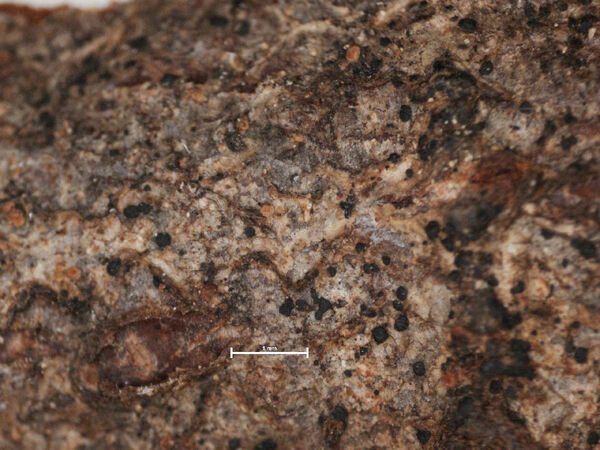Arthonia tenellula Nyl.
Flora, 47: 488, 1864.
Synonyms: Allarthonia tenellula (Nyl.) B. de Lesd.
Distribution: C - Umb (Ravera 1998, 1999, Ravera & al. 2006), Laz (Ravera 2002b). S - Cal (Puntillo 1996).
Description: Thallus crustose, endosubstratic or very thinly episubstratic, continuous, pale grey-white to greenish grey, mostly inapparent, without a distinct prothallus. Apothecia arthonioid, emarginate, adnate, black, epruinose, rounded, 0.1-0.15(-0.2) mm across, mostly flat, scattered on gathered in groups of up to 10, without a proper margin. Proper exciple very poorly developed, of paraphysoid-like hyphae; epithecium brown-black, c. 10 μm high, K-; hymenium colourless to yellowish green, not inspersed with oil droplets, (20-)30-40 μm high, hemiamyloid, I+ wine-red, K/I+ blue; paraphysoids thread-like, very thin, the apical cells not swollen, without a brown cap; hypothecium pale green to colourless. Asci 8-spored, broadly clavate to ovoid, semi-fissitunicate, with a large apical dome and a distinct ocular chamber, Arthonia-type. Ascospores 1-septate with more or less equal cells, hyaline, long ovoid, straight, with rounded ends, (8-)10-13 x (3-)4-5 μm. Photobiont chlorococcoid. Spot tests: thallus K-, C-, KC-, P-, UV-. Chemistry: without lichen substances.Note: on smooth bark and lignum. The complex of A. apatetica-A. exilis deserves further study. This species, described from a coastal site in western France and reported from scattered localities in Europe, is included in the Italian red list of epiphytic lichens as “Vulnerable” (Nascimbene & al. 2013c).
Growth form: Crustose
Substrata: bark and lignum
Photobiont: green algae other than Trentepohlia
Reproductive strategy: mainly sexual
Pioneer species
Poorly known taxon in need of further study
Commonnes-rarity: (info)
Alpine belt: absent
Subalpine belt: absent
Oromediterranean belt: absent
Montane belt: absent
Submediterranean belt: very rare
Padanian area: absent
Humid submediterranean belt: very rare
Humid mediterranean belt: absent
Dry mediterranean belt: absent

Predictive model
Herbarium samples
Growth form: Crustose
Substrata: bark and lignum
Photobiont: green algae other than Trentepohlia
Reproductive strategy: mainly sexual
Pioneer species
Poorly known taxon in need of further study
Commonnes-rarity: (info)
Alpine belt: absent
Subalpine belt: absent
Oromediterranean belt: absent
Montane belt: absent
Submediterranean belt: very rare
Padanian area: absent
Humid submediterranean belt: very rare
Humid mediterranean belt: absent
Dry mediterranean belt: absent

Predictive model
| Herbarium samples |
 INDEX FUNGORUM
INDEX FUNGORUM
 GBIF
GBIF


